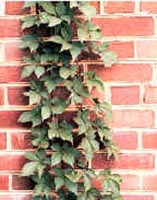Resource Library
Plant of the Week: Virginia Creeper
The University of Arkansas System Division of Agriculture does not promote, support or recommend plants featured in "Plant of the Week." Please consult your local Extension office for plants suitable for your region.
Plant of the Week
Virginia Creeper
Latin: Celosia Parthenocissus quinquefolia

Mistaken identities are as common with plants as they are with people. Just as singer Woody Guthrie described outlaw Pretty Boy Floyd as being accused of every crime in Oklahoma during the Great Depression of the 1930s, people who venture into the woods are quick to blame their rashes on Virginia creeper, an innocent bystander.
Because Virginia creeper is a vine that grows in the woods, people jump to the conclusion that it must be poison ivy. About the only characteristic Virginia creeper (Parthenocissus quinquefolia) shares with poison ivy is that it grows in the woods. But so do oak trees and bears, and people hardly ever seem to confuse them.
The easiest way to tell these two vines apart is the leaves. Virginia creeper has five leaflets, while poison ivy has three. The five well-notched leaflets are 4-6 inches long and attached to a long petiole. Leaves of Virginia creeper are a deep metallic blue-green on top with a lighter undersurface, while poison ivy is a sickly yellow-green. In the fall, Virginia creeper leaves turn bright scarlet or maroon-red.
Virginia creeper has one of those interesting scientific names that just seem to roll off your tongue -- assuming it's a well lubricated tongue. The genus name is from the Greek word parthenos, which means virgin and refers to Virginia, which was named after England's virgin queen, Elizabeth I. The second part of the name, kissos, is Latin for ivy. The epitaph translates literally as "five leaves."
Poison ivy, with its distinctive three-lobed leaves, either climbs trees as a vine or forms free-standing "bushes" 2-3 feet tall. The bush form is referred to as "poison oak." The stems produce thousands of rootlets that attach the vine to the tree, looking like some irradiated millepede as it climbs skyward.
While poison ivy ranges throughout Canada and the United States all the way to Central America, Virginia creeper is mostly limited in distribution to the eastern states and parts of northern Mexico.
Virginia creeper has holdfasts that are branched with five to seven distinct tips. The tips flatten on the end like suction cups and anchor the vine to the tree or wall. These holdfasts secrete calcium carbonate, the basic component of cement, and literally mortar themselves to their support.
Unlike poison ivy, Virginia creeper will sprawl across the ground and can even be used as a deciduous groundcover.
Virginia creeper is a member of the grape family. It produces clusters of pea-sized blackish-purple berries in late summer and fall. These are relished by birds who spread the seeds with reckless abandon throughout the shrub border and flower beds. While hardly a pernicious weed, new vines have to be pulled regularly or they can get out of control.
Fast growing vines such as Virginia creeper have limited use in the average garden because they are too rambunctious. But if you have a chain link fence to cover, or you're deciding how to tone down your new Lincoln log concrete block wall, a fast growing vine like Virginia creeper might just fill the bill.
Virginia creeper will grown in sun or shade and is pretty much indifferent to soil conditions so long as it's not too wet in the winter.
By: Gerald Klingaman, retired
Extension Horticulturist - Ornamentals
Extension News - September 7, 2001
The University of Arkansas System Division of Agriculture does not maintain lists of retail outlets where these plants can be purchased. Please check your local nursery or other retail outlets to ask about the availability of these plants for your growing area.